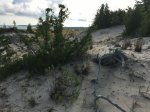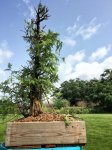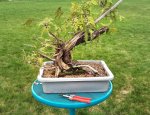Matt,
I think theres a simple answer to why it gets a bad rap. People don't know how to use it. There's hardly any information online, and the strong, extending fronds can make it difficult to miniaturize. People are either scared to try it, or when they do they get negative results. Fronds grow too much, lose proportion to the tree. Dense ramification is difficult because the fronds are so large, etc.
I don't have experience in it, but I have one in my yard that the family was going to dig up. I told them to give me two years to get it closer to something I can put in a grow box and that I would lift it for them. Their main concern was overcrowding of the actual landscape trees. (As bonsaists, we can deal with taking a tree that is overcrowding. Knowing that it's going to be killed otherwise, it really takes away our chopping inhibition). So that's what I did. The tree formed from sucker growth, I believe. Since it sprouted right next to the landscape trees. It's been growing for 7 years, and had gotten to about 6 and a half feet tall. I cut it down to roughly four feet in late May (Terrible timing, I know now but didn't then). Along with trunk chopping I would say I got rid of about 70 percent of it's growth. It was one main trunk with sparse branching, and like 10 sucker trunks growing from the base. I got rid of all the extra "trunks." eliminated anything that was shading out a significant portion of the now bare main trunk. Fast forward to now, the tree has back budded like crazy. All along it's perfectly straight, 3 inch in diameter trunk.
So, I butchered the thing, did it in the wrong month, got rid of a majority of it's growth, and it still pushed all kinds of new growth. I haven't given it any special attention either. Just let it be a tree. What does that tell me? the species Thuja Occidentalis is incredibly strong, back buds from thick, older growth, and can handle at least a fairly decent amount of foliar reduction. All things that we ascribe to have in our trees. Now, it is in the ground. I wouldn't do such a crazy amount of reduction once it is lifted, but the basis is there to realize they backbud like mad.
So, not enough information, and a lot more attention to detail with them is probably why they get a bad rap, because their back-bud, chop, and growth potential seems spectacular.
Please PM me some tips if you deal with these often. I want to know what I can do once I get it out of the ground. I will PM you photos when I get home.


 Thuja's foliage is not everyone's favorite but neither is Ponderosa. On the other hand the color of Thuja foliage is really nice. It back buds. When properly wired Thuja foliage has a natural and layered look that is really pleasing. Some of the oldest trees in the world especially in the eastern US are Northern white Cedar.
Thuja's foliage is not everyone's favorite but neither is Ponderosa. On the other hand the color of Thuja foliage is really nice. It back buds. When properly wired Thuja foliage has a natural and layered look that is really pleasing. Some of the oldest trees in the world especially in the eastern US are Northern white Cedar. 








